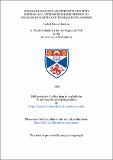Files in this item
Medical images in eighteenth-century British art, with special reference to William Hogarth and Thomas Rowlandson
Item metadata
| dc.contributor.advisor | Kemp, Martin | |
| dc.contributor.author | Haslam, Isobel Fiona | |
| dc.coverage.spatial | 2 v. | en_US |
| dc.date.accessioned | 2018-07-11T13:23:07Z | |
| dc.date.available | 2018-07-11T13:23:07Z | |
| dc.date.issued | 1993 | |
| dc.identifier.uri | https://hdl.handle.net/10023/15252 | |
| dc.description.abstract | The objective of this thesis is to show that a study of medical images produced by British artists in the eighteenth century can contribute to the knowledge of the social history of medicine of the period, and to show that, by careful analysis of the medical images portrayed, some insight may be obtained into the meaning of works of art in which such images might otherwise be dismissed as merely irrelevant or gratuitous details. The thesis is cast In two main sections preceded by an introductory chapter which provides some background information with regard to the development of medical services in England and sets the scene from which literary and graphic artists drew their images, Works of the artist William Hogarth form the basis of the first section, The artist made extensive and knowing reference to medical imagery in many of his works, some of which are described and interpreted with due regard to the conventions employed, to the world around him, to literary works of his contemporaries and, where appropriate, to contemporary medical literature, Independent control with regard to the validity of the medical images and practices portrayed is provided where descriptions of such practices and Images correspond with each other. It is contended that such integration of written and visual sources of medical Imagery, in an empirical approach, enhances the information to be gained from either source viewed separately. Although mainly satirical in nature, it is argued that the images must have a foundation of truth and therefore deserve to be examined closely so that the truth of the situation portrayed may be revealed. The second section discusses the use of medical images from the late eighteenth century and early nineteenth century, mainly through the works of Thomas Rowlandson, although works of other artists such as James Gillray and George Cruikshank are included. Through their works information may be gleaned about a range of contemporary medical issues including lay perceptions of disease, pain and death, fashions in disease and treatment and the impact that advancing scientific knowledge had upon medical treatment and upon the practitioners involved. In addition, certain contemporary philosophical ideas are highlighted which have some bearing upon contemporary popular and medical opinion. The nature and function of medical images are discussed throughout the thesis. They are read, not as straightforward documents, but within a framework of recognisable practices. Medical and artistic changes took place throughout the century and the effects of some of these changes are commented upon during the course of the thesis, which concludes by assessing the arguments put forward in both sections and indicates how the two disciplines of the History of Art and the social History of Medicine can be bridged or annexed with benefit to both. | en_US |
| dc.language.iso | en | en_US |
| dc.publisher | University of St Andrews | |
| dc.subject.lcc | N8223.H2 | en |
| dc.subject.lcsh | Medicine and art | en |
| dc.title | Medical images in eighteenth-century British art, with special reference to William Hogarth and Thomas Rowlandson | en_US |
| dc.type | Thesis | en_US |
| dc.type.qualificationlevel | Doctoral | en_US |
| dc.type.qualificationname | PhD Doctor of Philosophy | en_US |
| dc.publisher.institution | The University of St Andrews | en_US |
This item appears in the following Collection(s)
Items in the St Andrews Research Repository are protected by copyright, with all rights reserved, unless otherwise indicated.

